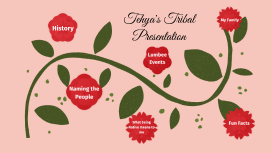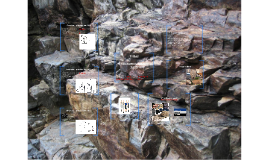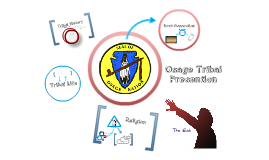Tribal Presentation
Transcript: Tribal Presentation of the 9 Tribes of Northeast Oklahoma by Traci Munson Modoc Land The Modoc lived near the California-Oregon border, near the Cascade Mountains and what is now the Lava Beds National Park. Their current tribal offices are in Northeast Oklahoma, Miami, OK to be exact. The Modoc and Klamath tribes were terminated from federal supervision in 1956. Several years later all tribes in the northeastern corner of Oklahoma came together to establish the Inter-Tribal Council, Inc. of Northeastern Oklahoma. At that time, the Modoc formed an unofficial tribal government. The Modoc Tribe in Oklahoma was granted federal recognition in May 1978. This made them eligible for federal assistance. Bill G. Follis great grandson of James Long, became chairman in 1973. When the tribe was granted Federal Recognition in 1978, Chief Follis became the first federally recognized chief of the Modoc in Oklahoma since the death of Bogus Charley in 1880. In 1998, the Modoc and Miami tribes entered into a joint venture to establish The Stables; an off track betting and high stakes bingo establishment located next door to the Modoc Tribal Complex. Under Chief Follis' leadership, the tribe has reintroduced bison to the Modoc prairie with a thriving and ever growing herd. Current Modoc tribal enrollment is around 200. The Modoc people learned to live with the influx of non-Native American people. They worked for them, traded with them, and eventually even began to dress in similar fashion to the "'white" people. In 1864, the Modoc people signed a treaty and agreed to live with the Klamath Indians, who were traditionally their enemies. They were harassed by them, and conditions were poor so Captain Jack led a group away from the area to the Lost River in California. In 1870 after living away from the reservation for more than 2 years the U.S. Army decided to capture them and return them to the Klamath reservation. This was the event that began the Modoc War. Ottawa Tribe The name “Ottawa” is from the Indian word “adawe” meaning to trade. The Ottawas are made up of descendants of tribal members from Michigan and Ohio. In the 1800s they were moved to Kansas and then to Oklahoma. The Ottawa were very interested in education and used 20,000 acres to create an Indian Baptist school which is now Ottawa University. Tribal members can attend college there for free and their only expense is books. The tribe runs High Winds casino near Miami, Oklahoma. Their chief is Ethel Cook. http://www.ottawatribe.org/ The Peoria Tribe of Indians of Oklahoma is a confederation of Kaskaskia, Peoria, Piankeshaw and Wea Indians united into a single tribe in 1854. These tribes originated near the Great Lakes two to three thousand of years ago. The tribe now has headquarters in Miami, Oklahoma. Their chief is Bill Froman. The Peoria Tribe has business ventures that include Buffalo Run Casino and Hotel as well as Peoria Ridge Golf Course. http://peoriatribe.com/ Peoria Tribe Seneca Cayuga Tribe Eastern Shawnee Tribe Modoc Shawnee Eastern Shawnee Quapaw Miami Ottawa Peoria Seneca Cayuga Wyandotte Shawnee Tribe The war was one of the most notable in history. The warriors and their families moved to the Lava Beds. Captain Jack and his warriors (less than 60 men) fought almost 1,000 U. S. Military men for almost 6 months, and lost only 6 men in combat. The U.S. Army suffered 45 deaths including E.R.S. Canby, the only general to be killed in an Indian war. The Modoc War cost the United States government, at its lowest estimate, half a million dollars. Considering the number of the enemy, it was probably the costliest Indian war ever fought. The reservation requested by the Modoc on Lost River would have cost, at most, $10,000. Modoc War Tribal Offices Modoc People The Wyandotte tribe originated along the Saint Lawrence River in the Upper Great Lakes region. There were about a dozen closely related tribes included in the Iroquois Linguist group that is now the Wyandotte tribe. In the 1800s they were removed to Kansas territory and then later purchased land from the Delaware tribe and moved to Ottawa county in Oklahoma. Currently their tribal enrollment is near 5,800 members with 1,200 members living in Oklahoma. They currently operate the Wyandotte Casino in Wyandotte, Oklahoma and have many services and businesses. http://www.wyandotte-nation.org/ Miami Tribe Wyandotte Nation Website http://www.modoctribe.net/ Modoc Tribe Quapaw Tribe The Miami Tribe of Oklahoma is the only federally recognized Native American tribe of Miami Indians in the United States. The people are descended from Miami who were removed in the 1800s from their traditional territory in Indiana, Michigan and Ohio. Their tribal headquarters are located in Miami, Oklahoma. There are over 4,000 citizens living in all 50 states. The tribe has 2 casinos and their chief is Doug Lankford. http://www.miamination.com/ The Quapaws lived by the Atlantic Ocean and were known as Downstream People. In

















